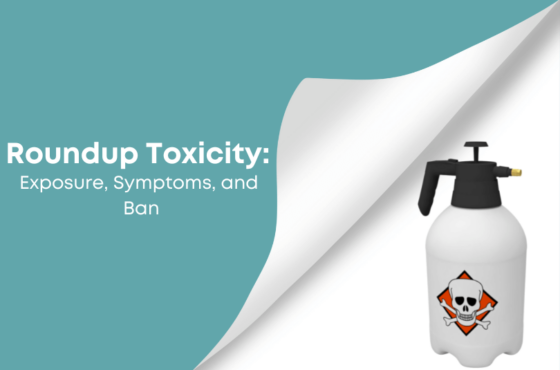Roundup is the brand name of the most widely used agricultural chemical in the United States. Since the herbicide was first introduced to commercial agriculture in 1974, American farmers have been putting their faith in Roundup to keep their farms weed-free.
However, concerns about the safety of the herbicide started to grow in 2015, when the International Agency for Research on Cancer (IARC) assessed studies and concluded that glyphosate – the ingredient that kills weeds in Roundup – is probably carcinogenic to humans.
This report from the IARC prompted thousands of plaintiffs to file a Roundup lawsuit, where they claim that the popular Roundup weed killer caused them to develop cancer.
What is Roundup?
Roundup is a glyphosate-based herbicide that kills weeds by inhibiting plants to produce proteins that are essential to their growth. It has been around for decades and has been primarily used in agriculture, but is also a staple in lawn and garden care for many Americans.
Roundup’s key ingredient, glyphosate, is the compound that kills weeds that compete with crops. But even though the product improves yields and cuts costs for farmers, the risks may easily outweigh its benefits.
Does Roundup contain Glyphosate?
Yes, Roundup contains glyphosate. Glyphosate is the active ingredient in Roundup, and it acts by targeting certain enzymes that are needed for plant growth. The compound is also a non-selective herbicide, which means that it is designed to kill most plants it comes in contact with.
This herbicidal effectiveness is the very reason why up to this day, many farmers still depend on Roundup glyphosate for their farm practices. It was only until recently that people realized how the chemical can persist in the environment, not only harming the ecosystem but also human health.
Are there any other weed killers that contain Glyphosate?
German company Bayer may be the biggest manufacturer who makes Roundup, but it is not the only company that produces glyphosate-based herbicide products. In fact, there are plenty of them. The other weed killers that contain glyphosate are listed below.
- Rodeo Aquatic Herbicide: Rodeo is another popular glyphosate-containing herbicide that provides control of aquatic weeds and plants. It is also a non-selective herbicide that works against annual weeds, perennial weeds, and woody plants.
- Eraser: a non-selective herbicide that contains 41% glyphosate as its active ingredient. It is used for the management of unwanted grassy and broadleaf weeds not only on agricultural settings but also on residential sites.
- Agrisel: a fast-acting weed killer that also contains 41% glyphosate and is sprayed on weeds and grasses. It is often used in lawns, turfs, golf courses, other non-crop areas, and farms.
- Alligare: a systemic herbicide that has 53.8% glyphosate and is labeled for aquatic and noncrop uses. It controls annual weeds, perennial weeds, and herbaceous and woody plants.
- Remuda: a 41% concentrate of glyphosate. It is a non-selective herbicide that controls both annual and perennial grass, as well as broadleaf weeds. It works by entering the foliage and traveling through the underground roots.
Is Paraquat in Roundup?
No, paraquat is not in Roundup. Paraquat is the active ingredient in Gramoxone, another popular brand of a weed killer that is equally controversial and is the subject of thousands of lawsuits because of its dangerous health effects, one of which is Parkinson’s disease.
As mentioned, the active ingredient in Roundup is glyphosate. However, the product is not only made of glyphosate alone, but is composed of a combination of various chemicals. According to experts, this cocktail of Roundup ingredients is what makes Roundup more toxic and therefore more dangerous to humans.
What are Roundup Ready crops?
Roundup ready crops are genetically engineered crops that are resistant to glyphosate. They were developed by former Roundup manufacturer Monsanto to reduce crop damage when Roundup is sprayed. The current Roundup ready crops are listed below.
- Soy: More popularly known as Roundup Ready Soybeans (RRS), they are glyphosate tolerant soybeans which were developed in 1996 by Monsanto. Since it was introduced, the large majority of soybean fields in the United States have been RRS. Despite its advantage, however, evidence exists that the use of these genetically engineered seeds do not actually lead to higher yields when compared to other non-genetically engineered varieties.
- Corn: Genetically engineered corns that are Roundup ready have had their DNA modified to withstand the weed-killing chemical glyphosate. In a 2012 study, one variety of glyphosate-resistant corn was associated with tumors in rats.
- Alfalfa: This Roundup Ready variety was the subject of lawsuits brought by alfalfa farmers and watchdog groups that sought to stop any of its planting. They claimed that the U.S. Department of Agriculture illegally approved Roundup Ready alfalfa without completing a required full Environmental Impact Statement first.
- Cotton: The adoption of RR cotton was rapid and widespread because of its known advantages in broad-spectrum weed control. But since then, weed scientists have been concerned that they could cause the development of weeds and other plants that are also glyphosate-resistant.
- Sorghum: RR sorghum is a genetically engineered whole grain cereal crop that contains glyphosate-tolerant genes. As with other RR crops, the main concern over the sorghum variety is the development of herbicide-resistant super weeds that can spread through farms, even those that do not use herbicides.
What is the difference between Roundup and Paraquat?
The main differences between Roundup and paraquat are their active ingredients and the health risks associated with them. While the active ingredient in Roundup is glyphosate, the active ingredient in paraquat is paraquat dichloride.
Glyphosate exposure has also been linked to a form of cancer called non-Hodgkin’s lymphoma, while exposure to paraquat has been linked to Parkinson’s disease. Lastly, paraquat has been found to be 28 times more acutely toxic than the Roundup chemical, according to a Pesticide Action Network report.
What does Roundup kill?
According to its website, there are over 200 types of weeds and grasses that Roundup concentrate products can help control. Some of them are listed below.
1. Roundup against weed
Roundup weed and grass killer is a popular formula for nonselective weed control, which means that it does not discriminate between weeds and desirable plants. In response to this, former Roundup manufacturer Monsanto developed its own line of genetically modified glyphosate-resistant crop seeds called Roundup Ready crops.
2. Roundup against nutsedge
Nutsedges are persistent weeds that commonly infest home landscapes. Roundup is used to kill all kinds of nutsedge, but it requires repeated applications and only results in limited suppression of nutsedges.
3. Roundup against tree of heaven
Tree of heaven is a fast-growing, weedy tree that crowds out native species and produces a chemical that is toxic to surrounding plants. Many urban dwellers or homeowners commonly use Roundup herbicide and apply the chemical on the foliage or cuts on the stem to control the tree of heaven.
4. Roundup against poison ivy
There is a variation of Roundup specifically formulated to kill poison ivy. It is directly applied to poison ivy foliage, but may require several applications and around seven to 14 days to eradicate poison ivy.
5. Roundup against bamboo
Glyphosate, when used at high rates, can help control and remove bamboo. However, evidence shows that for herbicides to be effective, the bamboo should be chopped first and be allowed to regrow to a height of three feet.
6. Roundup against morning glory
Herbicides like glyphosate Roundup are known to have an important role in the management of morning glory because it kills the roots. However, the chemical also kills other plants it contacts, so users must practice caution in its application.
7. Roundup against wisteria
One way to get rid of wisteria is by using Roundup, particularly by spraying the chemical on its leaves. Glyphosate is absorbed into wisteria’s plant tissues and kills the entire plant in about a week.
8. Roundup against poison hemlock
Roundup is one of the herbicides that can effectively get rid of poison hemlock. A 41% or higher concentration of glyphosate is needed to control the deadly plant, and the chemical should be mixed with a 2% product spray solution.
What are the Side Effects of Roundup?
Ever since glyphosate was classified as a probable human carcinogen by the IARC, critics and consumers alike began taking a serious look at its health risks. The most common side effects of Roundup are listed below.
- Eye irritation: Getting Roundup in your eyes may cause irritation, itching, burning sensation, and even superficial corneal injury. Carefully reading and following Roundup instructions indicated in the label can help avoid getting the chemical in your eyes.
- Skin rashes: Cases of dermal exposure to glyphosate have led to skin irritation and chemical burns. However, with prolonged exposure, Roundup may also enter the skin over time. What’s worse is that Roundup that persists in the soil may contribute to dermal exposure as well.
- Burns in the mouth and throat: Swallowing products that contain glyphosate may result in increased saliva and burns in the mouth and throat. Moreover, accidental or intentional ingestion may also lead to extensive chemical burns, ulceration of the oral cavity, and eventual death.
- Nausea and vomiting: Ingestion of large amounts of glyphosate can cause gastrointestinal symptoms such as nausea and vomiting. These indications are often the initial symptoms of pesticide poisoning.
- Difficulty breathing: Another symptom of glyphosate poisoning is breathing difficulty. Exposure by inhalation is the route of exposure that typically results in the fastest appearance of symptoms.
- Respiratory illnesses: Roundup exposure increases the incidence of certain respiratory illnesses, such as asthma and impairment in lung function. Evidence also exists that exposure to cancer-causing agents like glyphosate may increase the risk of developing lung cancer.
- Non-Hodgkin’s lymphoma: Glyphosate, the active ingredient in Roundup, has been found to be a probable human carcinogen that is associated with the development of non-Hodgkin’s lymphoma, a form of cancer that usually develops in the lymphatic system.
Is Roundup harmful to humans?
Yes, Roundup is harmful to humans. Aside from being fatal to plants, several studies and international health organizations alike have linked glyphosate to a wide array of health risks. These include cancer, pregnancy problems, respiratory illnesses, reproductive health effects, kidney disease, and endocrine disruption, to name a few.
Does Roundup cause cancer?
Yes, Roundup causes cancer, particularly non-Hodgkin’s lymphoma (NHL). In fact, according to a report from the University of Washington Department of Environmental & Occupational Health Sciences (DEOHS), exposure to the chemical increases the risk of developing NHL by as much as 41%.
To date, Bayer has already paid billions to Roundup cancer lawsuit plaintiffs in order to settle claims. However, there are thousands more of these lawsuits that are still pending in court. Roundup has also been linked to other forms of cancer, including myeloid leukemia, kidney cancer, pancreatic cancer, and lung cancer.
Does Roundup cause Parkinson’s?
Yes, certain reports have suggested that glyphosate-based herbicides such as Roundup are associated with an increased risk of Parkinson’s disease. Its mechanism of action is also similar to paraquat – it causes death of neurons in the substantia nigra, a part of the brain that controls body movements.
This death of nerve cells also results from oxidative stress and mitochondrial dysfunction, which causes serious neurological diseases such as Parkinson’s disease.






